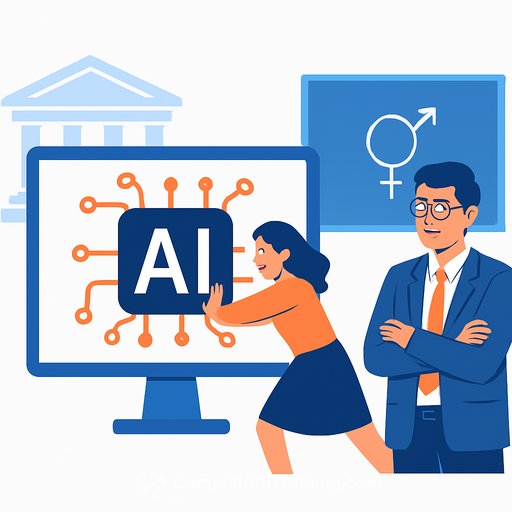CBSE to teach the language of artificial intelligence from Class 3 onwards
Starting April 2026, Class-III students in roughly 31,000 CBSE-affiliated schools will learn the basics of AI alongside subtraction, multiplication, reading comprehension, grammar, and sentence construction. The focus at the primary level: simple language models, safe chatbot prompts, and introductory generative AI concepts.
In parallel, AI is being woven into all degree programmes - BA, BCom, BSc, and specialised courses. The goal is a blended curriculum that prepares students for new roles emerging across sectors.
Why this matters for educators
The shift isn't a trend-it's a skills baseline. With an estimated 8 million Indians working in tech and AI influencing every function, schools and universities need a plan for curriculum, teacher development, infrastructure, and assessment.
Other countries have moved early: China added AI to high school in 2022, and several US states have introduced AI education from Kindergarten to Class XII. India's approach aims for depth at scale through CBSE, universities, and Atal Tinkering Labs.
What changes at the school level (Class 3 and up)
- Scope for Class 3-5: basic prompts, "how AI guesses the next word," safe and responsible use, and creative activities that reinforce language and math.
- Scope for Classes 6-8: prompt patterns, summarisation, classification, simple data representation, bias and reliability, and hands-on projects in ATLs.
- Scope for Classes 9-12: generative tools for research and projects, evaluation of sources, basic model limitations, ethics, and career awareness.
- Assessment: short performance tasks (e.g., "Write a clear prompt and improve it in two iterations"), reflective journals on AI assistance, and rubric-based evaluation of AI use.
What higher education institutions should do now
- Map AI across BA/BCom/BSc: add AI literacy, prompt fluency, data basics, and domain-specific AI use cases; embed ethical use and citation policies.
- Stand up micro-credentials and stackable modules that cut across disciplines, updated annually with industry input (including Nasscom).
- Faculty development: short, intensive PD on AI tools for teaching, assessment redesign, and academic integrity.
- Governance: publish an AI-use policy for students and faculty, including disclosure norms, acceptable tools, and data privacy.
What officials said
"We need to introduce AI in our school curriculum at the earliest. The Central Board of Secondary Education (CBSE) is working on it, and we have set a deadline of April 2026, when the new academic session begins, to introduce AI in the curriculum from Class-III onwards," said Sanjay Kumar, secretary, Department of School Education and Literacy, Ministry of Education.
Addressing concerns over job losses, he added: "Many people tell me that AI is something very different - unlike anything we have seen before. But I do not think so. My main concern is ensuring that everyone understands AI, because once people know it, they will find a way to adapt."
Higher Education Secretary Vineet Joshi noted the urgency: "Every university is responsible for its own curriculum, and each follows its own process. We must reach out to them with a sense of urgency - time is running out, and we need to move quickly. A large number of new roles are emerging, and to prepare students for them, we must rethink our general education structure."
Teacher capacity: the bottleneck and the plan
India has over 10 million teachers. Training is the make-or-break factor. Inputs are being sought from NITI Aayog and Nasscom to design an AI curriculum that teachers can deliver with confidence.
- Tiered PD: 6-8 hour foundations for all teachers; 20-30 hour track for ICT/ATL leads; ongoing clinics for use cases and classroom management.
- Resource kit: lesson plans, prompt libraries by subject, student safety guidelines, and assessment rubrics.
- Support model: state resource groups, mentor schools, and periodic webinars for Q&A.
Atal Tinkering Labs as the hands-on engine
With 50,000 ATLs being set up under the Atal Innovation Mission, almost every secondary and higher secondary student will have lab access. Integrating AI projects into ATL time can turn AI from a topic into a practice.
- Examples: prompt a story and illustrate it; build a quiz bot with safe, offline datasets; use generative tools to draft and refine project reports.
- Show the limits: test hallucinations, check bias, and compare AI output against textbook references.
90-day action checklist for school leaders
- Appoint an AI lead teacher per school; set up a 3-5 person working group.
- Audit infrastructure: device ratio, filtered access, and offline options.
- Run two pilot lessons per grade band (3-5, 6-8, 9-12) and collect feedback.
- Draft and publish a one-page AI-use policy for students and staff.
- Schedule a half-day PD on prompt basics, ethics, and assessment.
Practical classroom starters (Class 3-8)
- Prompt formats: role + task + constraints + length (e.g., "You are a librarian. Recommend 3 animal books for a 9-year-old, 2 sentences each.")
- Truth checks: "Ask the tool. Now verify with your textbook or teacher."
- Writing aid: outline → paragraph → refine tone; always cite AI assistance.
- Math aid: word-problem rephrasing and step-by-step hints, not final answers.
Policy and safety guardrails
- Data: no personal student information in prompts; use institution-approved tools.
- Disclosure: students indicate where and how AI assisted their work.
- Equity: ensure offline or low-bandwidth alternatives; pair-work on limited devices.
- Integrity: AI as drafting aid, not a substitute for original thinking; random viva checks.
For universities: quick wins this semester
- Create a 1-credit "AI for Learning and Work" course for all first-years.
- Embed AI citation policy in academic handbooks; update plagiarism workflows.
- Set up a faculty clinic to redesign 2-3 assessments per department with AI-aware rubrics.
- Engage industry advisory boards to define job-ready AI skills per discipline.
What happens next
If students encounter AI early and teachers have straightforward tools, adoption becomes normal and safe. As Sanjay Kumar noted, the priority is making sure everyone knows the basics-because familiarity leads to better use and better outcomes.
Resources
- NITI Aayog: National Strategy for Artificial Intelligence
- Atal Tinkering Labs (AIM): Overview and access
- Complete AI Training: Courses by job role (teacher and admin upskilling)
Your membership also unlocks:






